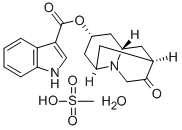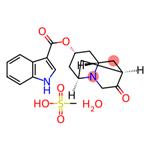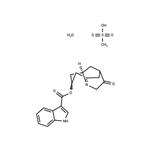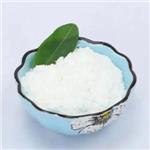Antiemetics
Vomiting is an extremely complex reflex activity, involving a variety of neurotransmitters. Antiemetics produce antiemetic effect by blocking different receptors.
5-HT3 receptor blocking drugs can selectively block the 5-HT3 receptors of the central and vagal afferent fibers , resulting in strong antiemetic effect. For vomiting caused by anticancer drugs, its antiemetic effect is quick and powerful, but it is invalid in vomiting caused by motion sickness and apomorphine.It is clinically used for chemotherapy, radiotherapy-induced nausea and vomiting.
Clinical application includes ondansetron (Zofran), granisetron , dolasetron mesylate, dolasetron and tropisetron , its clinically equivalent doses are 8mg, 3mg, 100mg and 5mg.
Dolasetron mesylate is an anti-emetic drug, it is originally developed by the German company Hoechst Marion Roussel , it is developed as a selective serotonin (5-HT3) receptor antagonist, its acting is similar to Ondansetron and granisetron. The oral administration and intravenous injections of the product are effective for preventing and treating nausea and vomiting caused by cancer chemotherapy. 5-HT3 receptor antagonist in combination with dexamethasone or other corticosteroids is the most effective combined therapy for the prevention of acute vomiting caused by cancer chemotherapy . US FDA suggests that the product can also be used for the prevention and treatment of postoperative nausea or vomiting. Dolasetron mesylate is rapidly metabolized to hydrogenated dolasetron in plasma and liver , the active metabolite in the liver is further metabolized by the CYP2D6 and CYP3A , then it is excreted with urine and feces, the half-life of the product is about 8h.
Clinical Study
Antiemetic effect of this product is stronger than any other 5-HT3 receptor antagonists. Randomized trial of 609 cases of patients with cisplatin showed that single intravenous dose of the product 1.8mg/kg for the prevention of acute emesis in full force is 49%, effective rate of the product 2.4 mg/kg intravenously is 46%,effective rate of intravenous ondansetron 32mg is 50%. Antiemetic effect of this product intravenous is equal to granisetron . A single oral dose of 100mg of this product in patients adopting moderate antiemetic measures, can completely prevent about 60% of patients vomiting.
The above information is edited by the chemicalbook of Tian Ye.
Adverse reactions and precautions
Adverse reactions of dolasetron mesylate are similar to Ondansetron and granisetron,including a slight headache, dizziness, dose-related transient ECG changes may occur, clinical symptoms are usually not obvious , they can be recovered by themselves. An increased incidence of hepatocellular adenoma and carcinoma will occur in mouse using this for 2 years.
Dolasetron is not appropriate used with drugs that affect the heart function (QT prolongation) , such as astemizole, terfenadine, cisapride, pentamidine, tricyclic antidepressants (eg Amitriptyline ), phenothiazines drugs (such as chlorpromazine), pimozide, sparfloxacin, antiarrhythmic drugs (eg quinidine, procainamide, amiodarone, bepridil, A atenolol). It is also not compatible with diuretics, anthracycline anticancer drug (such as idarubicin, doxorubicin, daunorubicin), cimetidine, rifamycins (eg, rifampin), or phenytoin carbamazepine.
Before using this drug, we should pay attention to history, including allergies (especially drug allergies), heart disease, electrolyte imbalance such as low potassium or low magnesium.
Because the drug can cause dizziness, when engaged in tasks requiring alertness (such as driving), please use with caution.
Pregnant women, lactating women use with caution.
Description
Dolasetron was launched as Anzemet in Australia and the US for the
prevention of nausea and vomiting in chemotherapy patients. It is a highly potent
and very selective antagonist of 5-HT3 receptors ; it is the sixth in this class of
compounds to be marketed for the treatment of chemotherapy-induced emesis.
The last two approved in this class were Nazasetron (1994) and Ramosetron
(1996). Anzemet was prepared by a seven step sequence from a
cyclopentenecarboxylic ester via a Robinson-Schopf cyclisation of a dialdehyde
into a key 9-azabicyclo[3.3.l]nonan-3-one. In a clinical study with 164 cancer
patients treated with Dolasetron mesylate prior to Cisplatin, single doses of 10-
50 mg achieved major control of nausea and emesis in 73% of subjects and
were well tolerated. Results from pharmacokinetic studies in humans showed
that the clinical effects and duration of action seem to be due mainly to a major
plasma metabolite rapidly formed and very potent itself, the (+) enantiomeric
alcohol obtained by enzymatic reduction of the cyclic ketone.
Originator
Hoechst Marion
Roussel (Germany)
Uses
Dolasetron Mesylate acts as a bridged pseudopelletierine derivative; specific serotonin (5HT3) receptor antagonist. Antiemetic.
Uses
Nausea in chemotherapy;5-HT3 antagonist
brand name
Anzemet (Sanofi Aventis.
Veterinary Drugs and Treatments
Dolasetron may be effective in treating severe nausea and vomiting
in dogs and cats, particularly if caused by cancer chemotherapy
drugs. Because it is given once a day, the injectable form of dolasetron
is often preferred over ondansetron, a similarly effective antiemetic.
However, for oral use in small animals, dolasetron tablets
are too large (50 and 100 mg) to be practically administered.




